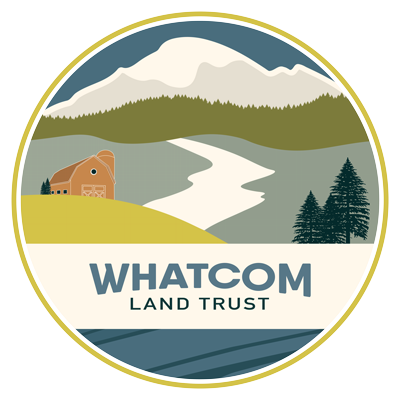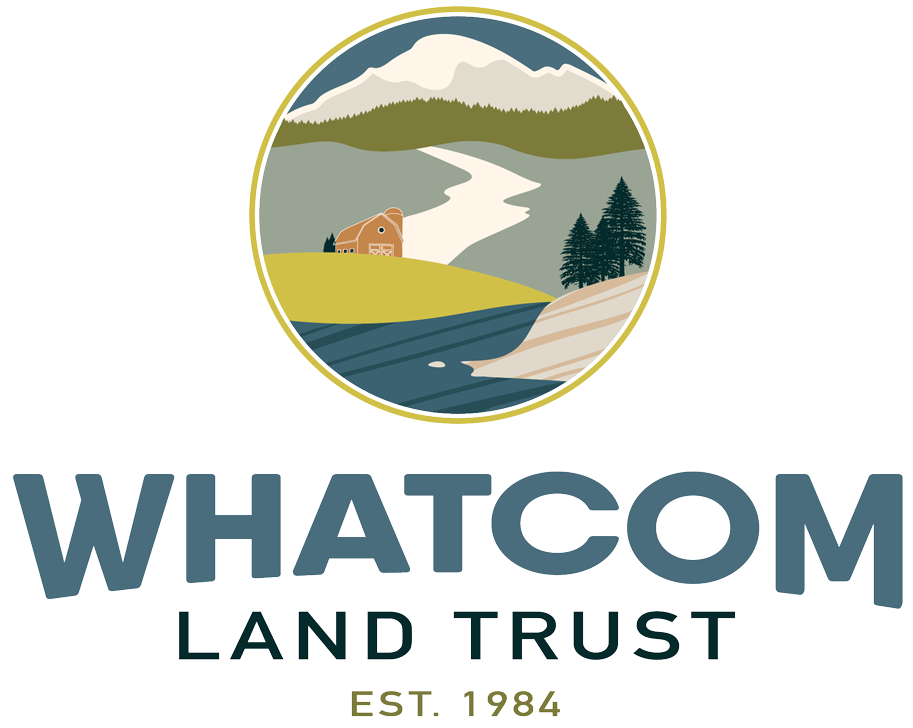The importance of habitat restoration in rebuilding salmon and orca populations
Southern Resident killer whales, or orcas, are emblematic of the Pacific Northwest, but sadly their population is declining at an alarming rate. Three pods of these whales were listed as endangered in the United States in 2005. Since then, there has been an immense effort to restore and protect these beloved creatures. Whatcom Land Trust has teamed up with the Whatcom Conservation District and the Nooksack Salmon Enhancement Association (NSEA) annually to host an information work party on the status of our resident pods.
There are currently six categories of challenges facing the Southern Resident killer whales: (1) prey, (2) vessels, (3) contaminants, (4) climate change, (5) funding and accountability and (6) future growth. Unlike other species of orcas, the Southern Resident pod’s primary source of food – an estimated 80% – is Chinook salmon. Chinook salmon are listed as a federally threatened species.
As an organization entrusted with the protection and preservation of wildlife habitat in Whatcom County, Whatcom Land Trust focuses on acquiring and restoring riparian habitat with the intention of improving salmon populations (and therefore orca populations) along the Nooksack River. One of our primary focus areas has been the South Fork due to the high temperatures and low flow currently impacting this section (you can read more about how temperature is impacting the river here).
The South Fork can be 10 degrees Celsius hotter than the North or Middle Forks, according to Alexi Guddal, Education & Outreach Technician for Whatcom Conservation District. “Chinook need cold water to survive, so it is incredibly important [for both salmon and orca recovery] to decrease the temperature of the South Fork to make it habitable for salmon species,” says Guddal.
Working to restore the Chinook salmon population is a vital step in the restoration and recovery of the Southern Resident killer whales.
“Anything we can do to help our Chinook will help our orca,” says Guddal.
On Saturday, October 22, Whatcom Land Trust teamed up with the Whatcom Conservation District and NSEA to host a work party in celebration of Orca Recovery Day. The event took place on Whatcom Land Trust’s California Creek Bridge Way property in the Drayton Harbor Watershed. Volunteers spent their morning planting native trees and shrubs as well as removing invasive blackberries along the creek.
“This work is important because I’ve learned that the salmon are affecting the orcas and I really love orcas,” said Ashanie Long-Reid, volunteer at Orca Recovery Day and member of the Association of Environmental Geologists at Western Washington University. “When I learned about this [work party], I really wanted to come out here and work for them (the orcas).”
Restoring the riparian buffer of this property will create cooler water temperatures in California Creek, which will make the creek a more habitable temperature for the Chinook salmon population. Additionally, the riparian buffer of native plants will also help to absorb different excess nutrients and pollutants that would have otherwise ended up in the water. By removing these harmful pollutants, these plants will further aid in the restoration of the Southern Resident killer whale populations because there will be lower concentrations of pollutants in both their diet (Chinook salmon) and their waters.
“Our orcas are some of the most toxic animals in the world, which is really sad,” says Guddal. “A lot of that is legacy pollution that we can’t do a lot about right now, but we can do a lot now and into the future to stop pollutants from continuing to be in our streams.”
“Each of our organizations has a really specific niche in our community,” says Sarah Brown, NSEA Stewardship Program Manager. “Salmon habitat is really what binds our three organizations together because no matter what we’re doing, salmon [and in turn orca] are a priority across our county.”
So what can you do to help?
- Keep your tires aligned and inflated. One of the pollutants that harms salmon, called 6PPD-quinone, comes from our car tires and when the tires aren’t properly aligned and inflated, more of those particles tend to rub off into ditches and streams. 6PPD-quinone harms a salmon’s sense of smell and they rely on their olfactory senses to reach their spawning destinations–meaning impaired fish can’t reach their spawning destination to deposit their eggs. This means that new Chinook aren’t born, which in turn, decreases the food source for our Southern Resident killer whales.
- Volunteer at community work parties! Community and organizational partnerships are vital in the effort to restore both salmon and orca populations. According to Guddal, “We can’t protect our natural resources unless we all work together.”
You’ll find more information about community work parties and other ways to get involved here.


